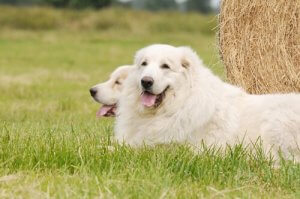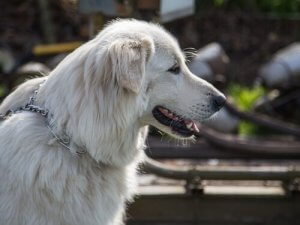All About The Pyrenean Mountain Dog

The Pyrenean mountain dog (or Great Pyrenees) is a large and imposing breed. They were originally bred to guard and protect livestock, as well as people’s homes. People often confuse the Pyrenean mountain dog with the Pyrenean mastiff. However, the two actually have very little in common, and are completely separate breeds.
If you’d like to learn more about this fascinating breed, read on, and we’ll tell you all about them.
The Pyrenean mountain dog – a majestic breed
Origins
The Pyrenean mountain dog is one of the oldest breeds in the world. Experts believe that they originate from the Basque region of Spain, as the earliest records of the breed come from that area. It’s said that local shepherds have used them to herd flocks for at least a thousand years. They were also the breed of choice in the French court, but they disappeared when the French Revolution broke out.
Since then, they have spread around the world. In fact, they’re now one of the most popular breeds in Australia and the US, often serving as farm and guard dogs.
The Pyrenean mountain dog – physical characteristics
Do you remember our previous article on molossers? Well, the Great Pyrenees is another member of this large canine family. However, their physical features are lighter than other molossers.
For example, males can weigh around 110 – 130 lbs, while females can weigh around 90 – 110 lbs. In the case of males, these dogs can measure anywhere between 27 and 31 inches at the shoulders, while females measure around 25 to 30 inches.
One unique characteristic of the Great Pyrenees is that they have six toes on their hind paws instead of five. Experts believe that breeders looked for this peculiarity with the idea that the dogs would have a better grip on snowy mountainsides.
Their coat is mainly white with gray patches, although official Kennel Club guidelines state that cream-coated dogs are also accepted. While rare, pure white Pyrenean mountain dogs are also accepted.

The Great Pyrenees isn’t one of the longest-living breeds in the world. In fact, they don’t usually live to more than 11 years old.
Temperament and behavior
These are some of the most loyal dogs you’ll ever find. In fact, there have been cases where Pyrenean mountain dogs have died trying to protect and save their owners from bears.
Unlike most other breeds, these dogs are highly independent. That said, their endless patience means they get on really well with children. They’re also extremely brave, and have a strong protective instinct. While they aren’t afraid of anything or anyone, there have never been any cases of a Great Pyrenees attacking its owner or another family member.
Although the role of guard dog comes naturally to them, they won’t just sit around waiting for something to happen. They will start to patrol the property to make sure no intruders slip past them. If they detect any signs of danger, they won’t think twice about protecting their owners, even if it means putting their own lives at risk.
The Pyrenean mountain dog – care
Because they have the habit of patrolling and keeping watch over their territory, Pyrenean mountain dogs require plenty of wide, open space. However, this space should be enclosed, as they have been known to leap over fences and disappear for hours, or even days.
Their coat needs daily brushing to remove any dead hair and prevent knots. Exercise will also play an important part in their lives, as they need to be active for at least one hour every day.
If you decide to adopt a Great Pyrenees, remember that their great size and strength mean they’ll need to eat a lot of food, and they can be expensive.
As you can see, the Pyrenean mountain dog is a really special breed, unlike any other on the planet. If you’re thinking of getting one, you’ll find no dog braver, more loyal, or more protective than the Great Pyrenees.
The Pyrenean mountain dog (or Great Pyrenees) is a large and imposing breed. They were originally bred to guard and protect livestock, as well as people’s homes. People often confuse the Pyrenean mountain dog with the Pyrenean mastiff. However, the two actually have very little in common, and are completely separate breeds.
If you’d like to learn more about this fascinating breed, read on, and we’ll tell you all about them.
The Pyrenean mountain dog – a majestic breed
Origins
The Pyrenean mountain dog is one of the oldest breeds in the world. Experts believe that they originate from the Basque region of Spain, as the earliest records of the breed come from that area. It’s said that local shepherds have used them to herd flocks for at least a thousand years. They were also the breed of choice in the French court, but they disappeared when the French Revolution broke out.
Since then, they have spread around the world. In fact, they’re now one of the most popular breeds in Australia and the US, often serving as farm and guard dogs.
The Pyrenean mountain dog – physical characteristics
Do you remember our previous article on molossers? Well, the Great Pyrenees is another member of this large canine family. However, their physical features are lighter than other molossers.
For example, males can weigh around 110 – 130 lbs, while females can weigh around 90 – 110 lbs. In the case of males, these dogs can measure anywhere between 27 and 31 inches at the shoulders, while females measure around 25 to 30 inches.
One unique characteristic of the Great Pyrenees is that they have six toes on their hind paws instead of five. Experts believe that breeders looked for this peculiarity with the idea that the dogs would have a better grip on snowy mountainsides.
Their coat is mainly white with gray patches, although official Kennel Club guidelines state that cream-coated dogs are also accepted. While rare, pure white Pyrenean mountain dogs are also accepted.

The Great Pyrenees isn’t one of the longest-living breeds in the world. In fact, they don’t usually live to more than 11 years old.
Temperament and behavior
These are some of the most loyal dogs you’ll ever find. In fact, there have been cases where Pyrenean mountain dogs have died trying to protect and save their owners from bears.
Unlike most other breeds, these dogs are highly independent. That said, their endless patience means they get on really well with children. They’re also extremely brave, and have a strong protective instinct. While they aren’t afraid of anything or anyone, there have never been any cases of a Great Pyrenees attacking its owner or another family member.
Although the role of guard dog comes naturally to them, they won’t just sit around waiting for something to happen. They will start to patrol the property to make sure no intruders slip past them. If they detect any signs of danger, they won’t think twice about protecting their owners, even if it means putting their own lives at risk.
The Pyrenean mountain dog – care
Because they have the habit of patrolling and keeping watch over their territory, Pyrenean mountain dogs require plenty of wide, open space. However, this space should be enclosed, as they have been known to leap over fences and disappear for hours, or even days.
Their coat needs daily brushing to remove any dead hair and prevent knots. Exercise will also play an important part in their lives, as they need to be active for at least one hour every day.
If you decide to adopt a Great Pyrenees, remember that their great size and strength mean they’ll need to eat a lot of food, and they can be expensive.
As you can see, the Pyrenean mountain dog is a really special breed, unlike any other on the planet. If you’re thinking of getting one, you’ll find no dog braver, more loyal, or more protective than the Great Pyrenees.
This text is provided for informational purposes only and does not replace consultation with a professional. If in doubt, consult your specialist.








